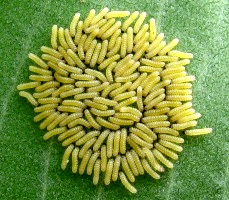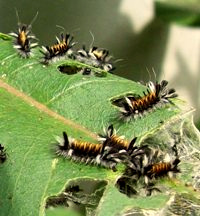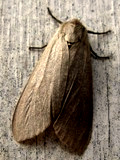You know that a butterfly or moth has different stages to go through before becoming an adult; first an egg, then a larva (or caterpillar), then the pupa stage where the caterpillar goes into a chrysalis or cocoon and then the adult. But did you know that larvae go through different stages too?
After the caterpillar cuts through its eggshell it begins to eat and eat and grow until its skin becomes too tight! So it must molt or shed its old skin. Later it will outgrow the new skin too and molt again. These different stages between molts are called instars. Moths and butterflies may go through around five instars before they reach their final instar just before turning into a pupa. In the final instar the mature larva may look nothing like the larva it looked like when it came out of the egg. It's grown bigger, maybe even changed colors and possibly grown hairs, maybe with tufts called "pencils" or even spines or bristles!
Here we take a look at the Milkweed Tussock Moth caterpillar. Its scientific name is Euchaetes egle. The female moth lays her eggs in clusters on the underside of a milkweed leaf.  It will most likely be a milkweed leaf because milkweed is the most common host plant for this type of caterpillar, but they can be found on dogbane too. Every species of caterpillar has their own host plant and they will not eat unless they have the right one!
It will most likely be a milkweed leaf because milkweed is the most common host plant for this type of caterpillar, but they can be found on dogbane too. Every species of caterpillar has their own host plant and they will not eat unless they have the right one!
When the larvae hatch from their eggs they are very tiny and cream colored in appearance. This is called the first instar. Each instar generally takes about five days to a week to complete.
They start eating the milkweed leaf. By eating milkweed plants it makes these little caterpillars toxic and not very good tasting to predators. This is called chemical defense. Together they skeletonize whole leaves, just leaving behind the viens.

In the above picture, taken only 24 hours later, they have begun to grow white hairs and you can see clearer their little black heads.
 In this picture on the left, they are bigger, more furry and now you can see the beginning of the black and white tufts of hair they have on the front and rear of their bodies.
In this picture on the left, they are bigger, more furry and now you can see the beginning of the black and white tufts of hair they have on the front and rear of their bodies.
They keep eating, growing bigger and now have many black and white hair "pencils" of different lengths on the front, rear and sides, with the middle segments having six pairs of thick orange and black tufts! These new bright contrasting colors make them easy to see and are a warning to predators that they are toxic.
 Although these caterpillars stick together for the first three instars, after that they start to spread out until in their final instar, when they head out on their own to find a place to safely go into their hairy cocoon which will protect them over the winter.
Although these caterpillars stick together for the first three instars, after that they start to spread out until in their final instar, when they head out on their own to find a place to safely go into their hairy cocoon which will protect them over the winter.

The adult moth's wings are dull in color but it has a bright yellow or orange abdomen with rows of black spots. You can learn more about Milkweed Tussock Moths by visiting Butterflies and Moths of North America website.
